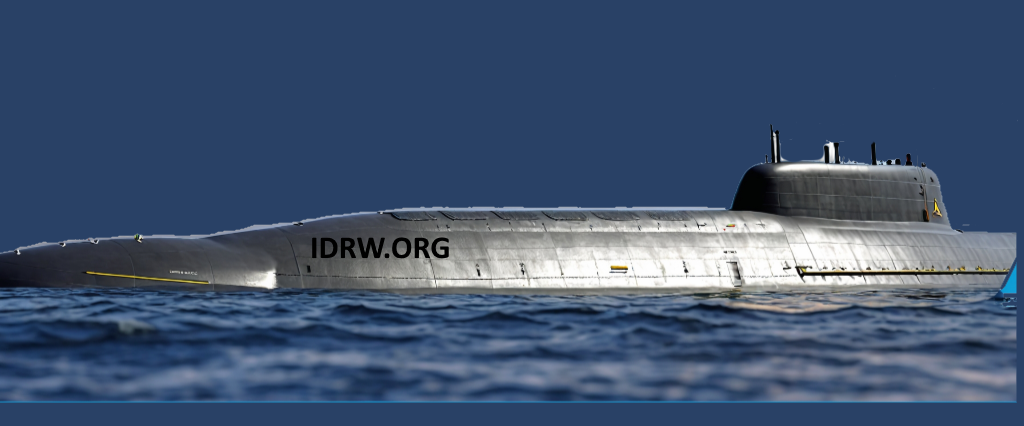SOURCE: IDRW.ORG

In a significant stride toward bolstering its naval deterrence, the Indian Navy is poised to leverage a newly completed submarine manufacturing complex dedicated to producing the next-generation S5-class nuclear-powered ballistic missile submarines (SSBNs). Satellite imagery and recent reports indicate that this state-of-the-art facility, located near the Cochin Shipyard, is now ready to commence production of the S5-class SSBNs, which are set to redefine India’s underwater strategic capabilities with their massive 13,000-ton submerged displacement. This development, as of April 1, 2025, marks a pivotal moment in India’s quest for a credible sea-based nuclear deterrent, aligning with its broader #AatmanirbharBharat initiative to achieve self-reliance in defence manufacturing.
The new complex, stretching over 600 meters, is designed to handle the simultaneous construction of three S5-class submarines before they are moved to an outer dry dock for final assembly. This capability underscores India’s intent to accelerate its SSBN program, ensuring a steady production pipeline to meet strategic imperatives. The S5-class submarines, with a submerged displacement of 13,000 tons, are nearly twice the size of the preceding Arihant-class SSBNs, which displace around 6,000 tons. This leap in scale allows for advanced nuclear propulsion systems, enhanced stealth features, and a larger payload of submarine-launched ballistic missiles (SLBMs), positioning the S5-class as a cornerstone of India’s nuclear triad.
The facility’s readiness comes at a crucial juncture, following the successful launch of the S4* SSBN in late 2024 and the commissioning of INS Arighat in August 2024. With INS Arihant and INS Arighat already on deep-sea patrols, and INS Aridhaman (S4) expected to be commissioned later in 2025, the Indian Navy is steadily building its underwater nuclear arsenal. The S5-class, however, represents a quantum leap, designed to carry up to 12 or 16 K-6 SLBMs, each equipped with multiple independently targetable reentry vehicles (MIRVs) and boasting ranges of 5,000 to 8,000 kilometers. This extended reach ensures India can target key adversaries from safer distances in the Indian Ocean, enhancing its second-strike capability.
The S5-class SSBNs will be powered by a 190 MW pressurized light-water reactor (PWR) developed by the Bhabha Atomic Research Centre (BARC), a significant upgrade from the 83 MW reactors in the Arihant-class. This new reactor, which requires refueling only once every 10 years, promises greater endurance and operational flexibility, allowing the submarines to remain submerged for extended periods. Additionally, the S5-class will feature pump-jet propulsion systems, reducing acoustic signatures and enhancing stealth—a critical factor for SSBNs tasked with evading detection while maintaining a credible deterrent.
The construction of the S5-class also benefits from advancements in materials, with the Steel Authority of India Limited’s (SAIL) Bhilai Steel Plant developing next-generation steel tailored for these underwater giants. This specialized steel, currently undergoing rigorous testing, is designed to withstand the immense pressures of deep-sea operations while ensuring structural integrity over decades of service. The integration of such indigenous technologies highlights India’s growing capability to design and build complex naval platforms domestically, reducing reliance on foreign imports.
Strategically, the S5-class SSBNs are a direct response to regional security dynamics, particularly the growing naval presence of China in the Indo-Pacific. With China’s Type 094 SSBNs displacing 11,000 tons and fielding JL-2 SLBMs with a 7,000-kilometer range, India’s S5-class aims to close the gap, ensuring a robust deterrent against potential threats. The ability to operate farther from India’s coast while retaining global strike capabilities—potentially with future K-7 and K-8 SLBMs ranging up to 13,000 kilometers—positions the S5-class as a game-changer in India’s nuclear posture.
While the new facility’s readiness is a cause for optimism, the S5 program faces challenges. The development of advanced SLBMs like the K-6, K-7, and K-8 remains a work in progress, with partial trials underway but full operational deployment still years away. The complexity of scaling up nuclear reactor technology and integrating it into a larger hull also poses engineering hurdles, as seen in past delays with the Arihant-class. Moreover, the Indian Navy’s initial plan for six S5-class SSBNs has been scaled back to four, to be built in pairs over two phases, reflecting budgetary constraints and the high cost of each submarine—estimated at $2.4 billion.
The facility’s focus on simultaneous production, however, offers hope for a streamlined timeline. If production begins as planned in 2027, the first S5-class SSBN could be inducted by the mid-2030s, ensuring India maintains a continuous at-sea deterrent. This aligns with the Navy’s long-term goal of operating a fleet of at least four SSBNs, a minimum threshold for credible deterrence, as seen in the fleets of nuclear powers like France and the UK.
NOTE : Article cannot be reproduced without written permission of idrw.org in any form even for YouTube Videos to avoid Copy right strikes. Websites doing illegal reproductions will get DMCA and Legal Notices.